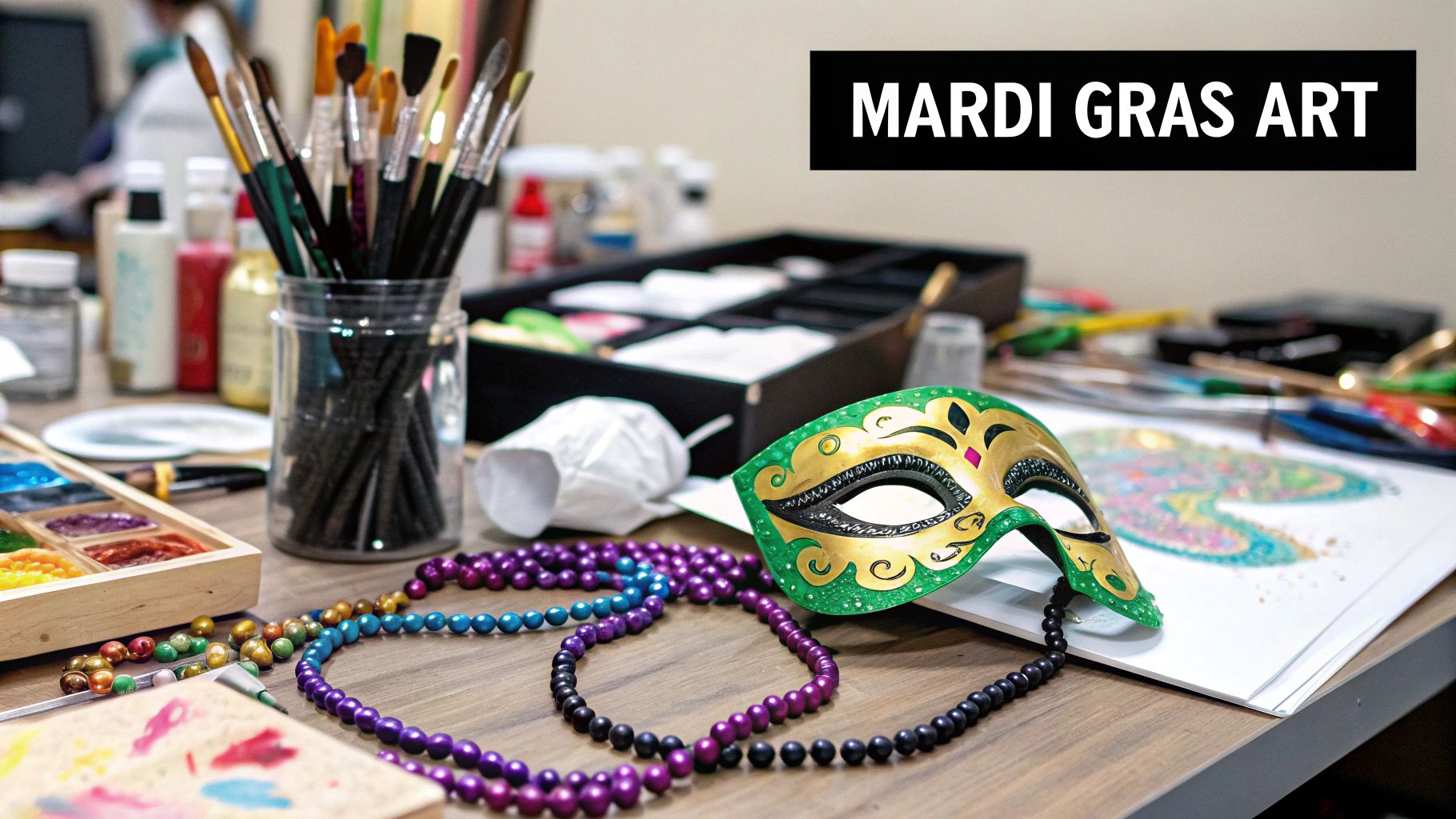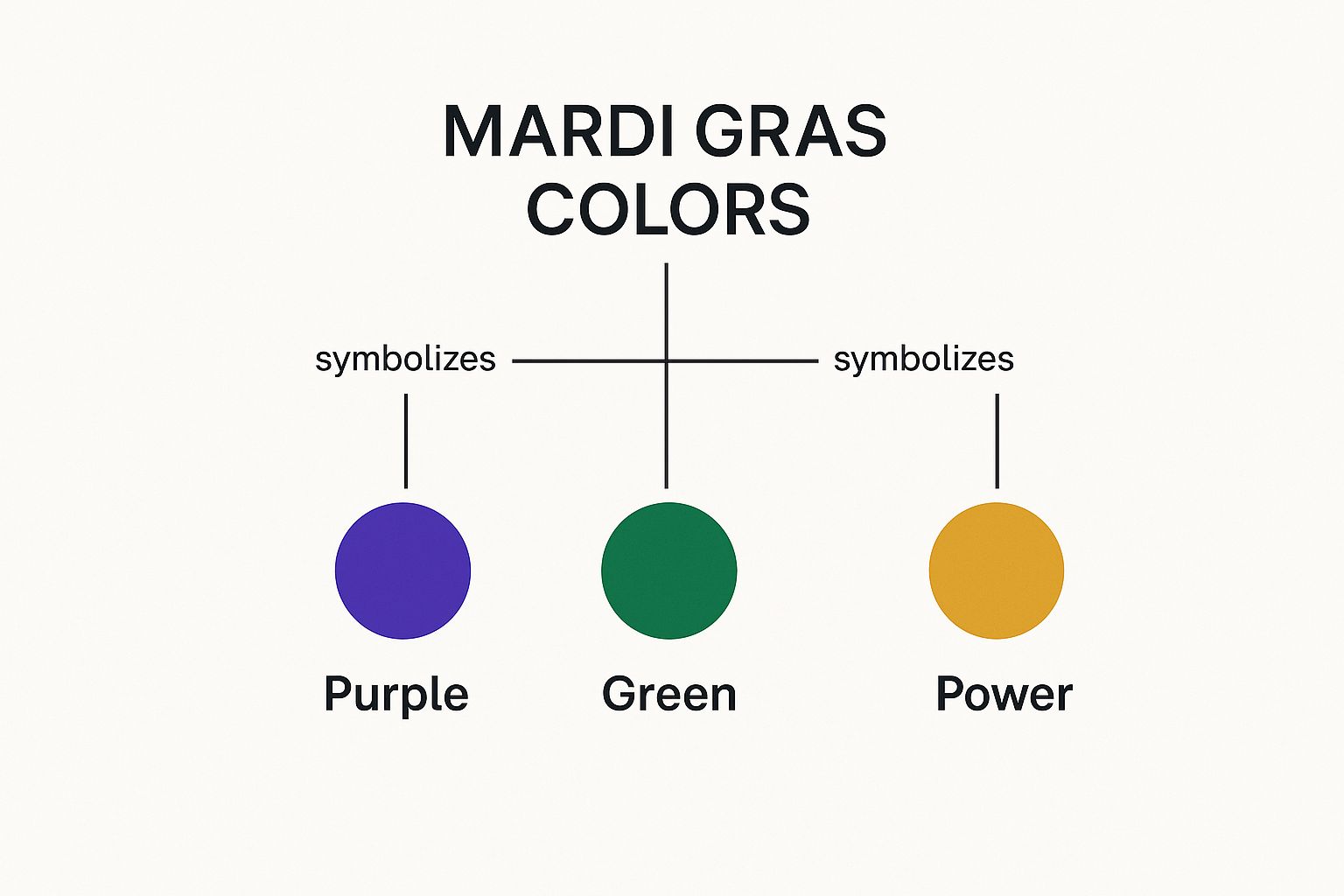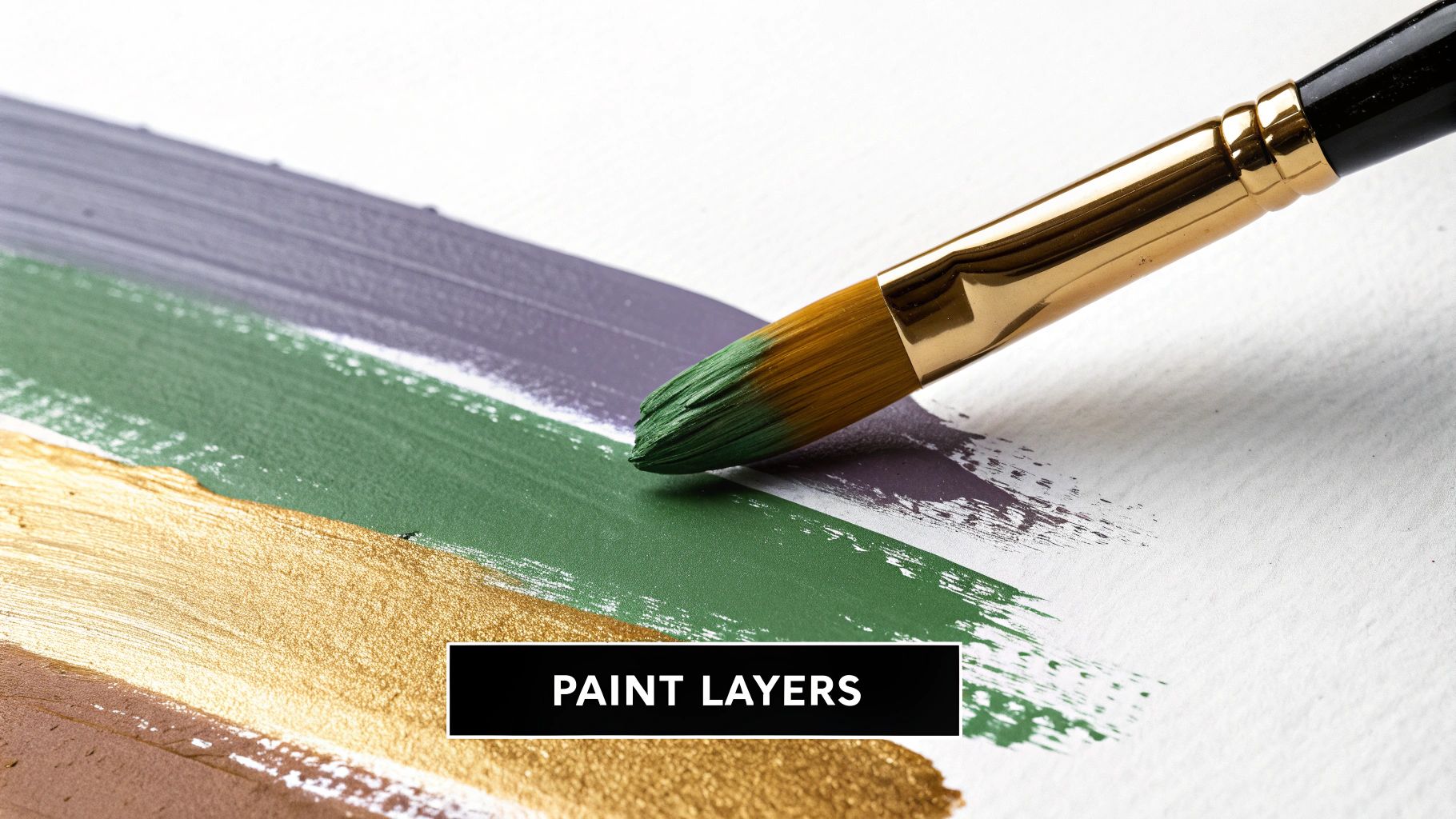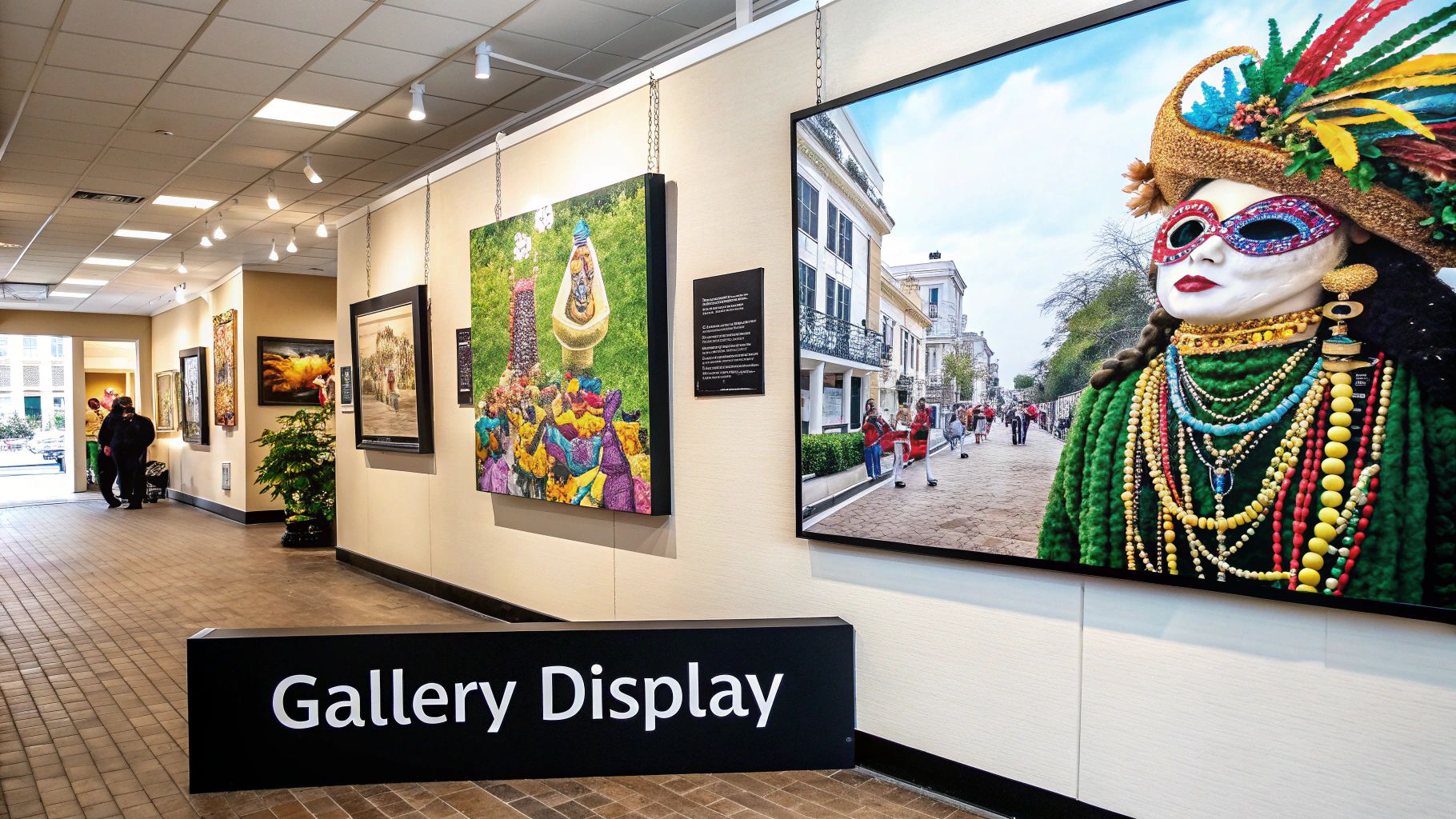If you've ever tried to explain Mardi Gras to someone who's never been, you know words often fall short. That's where a Mardi Gras painting comes in. It's an attempt to bottle that wild, joyful, and uniquely New Orleans lightning. These pieces are more than just pretty pictures of masks and beads; they’re a visual story capturing the very soul of Carnival.
So, What Makes a Painting a "Mardi Gras Painting"?

Think of it less as a rigid style and more as a shared feeling. It’s any piece of art that aims to freeze a moment of the festival's electric energy. It might be the blur of a parade float rolling down St. Charles Avenue, or the quiet mystery behind a masquerade mask. These artworks become little time capsules, preserving the fleeting magic of the celebration.
Artists approach this theme from every imaginable angle. Some go for the explosive, chaotic energy of the French Quarter, using bold, almost abstract splashes of color to convey the feeling of being in the crowd. Others might create stunningly detailed portraits of Mardi Gras Indians, focusing on the incredible craftsmanship and story woven into every bead of their suits.
The Heart and Soul of Carnival Art
What really ties these works together are the symbols they use. It’s a shared visual language that instantly connects the art to the traditions of the Crescent City.
You'll almost always find a few key players on the canvas:
- Masks and Jesters: These aren't just for show. They speak to the mystery and freedom of Carnival, a time when everyone can be someone else.
- Beads and Throws: They represent that classic moment of exchange—the chaotic, joyful connection between the people on the floats and the crowd below.
- Parade Floats and Krewes: These images capture the sheer scale and community effort that goes into making Mardi Gras happen.
- New Orleans Architecture: You can't separate the festival from its city. Think of those iconic iron-laced balconies, dripping with purple, green, and gold.
This isn't just art about a party. It's a love letter to a city's spirit. Each brushstroke tells a story about the traditions and creativity that define New Orleans. You can dive deeper into this unique culture in our article on the art of New Orleans.
From the Gallery to Your Living Room
One of the best things about Mardi Gras art is that it isn't just for serious collectors in stuffy galleries. It's found a huge following as home décor, giving people a way to keep that festive energy alive all year long.
This popularity means the art is incredibly accessible. You can find hundreds of options online, with smaller prints starting as low as $20. It’s a wonderful way for anyone, anywhere, to own a little piece of the celebration and make a personal connection to this amazing cultural event.
Diving into the Symbolism of Carnival Art
Every Mardi Gras painting tells a story. At first glance, you see the explosion of color and the pure joy of the scene, and that's absolutely captivating. But when you start to understand the symbols packed into the artwork, you unlock a much deeper appreciation for what you're seeing. These aren't just pretty pictures; they’re speaking the language of Carnival.
Think of the famous color trio—purple, green, and gold—as the alphabet of this visual language. These colors weren't just picked at random; they were chosen back in 1892 by the Krewe of Rex, and their meanings go way back. Each one carries a specific weight, turning a simple painting of a street party into something with real soul.
The Power of the Mardi Gras Colors
The meaning behind the colors gives you a peek into the heart of the celebration. They're not just for show; they represent the ideals that the first krewes wanted to stand for.
- Purple for Justice: This royal, stately color is a nod to fairness and what's right.
- Green for Faith: This one represents a deep-seated belief in the community's cultural and spiritual roots.
- Gold for Power: A reflection of the strength, prosperity, and enduring spirit of New Orleans and its people.
So, when an artist makes these three colors the star of a Mardi Gras painting, they're plugging directly into more than 100 years of history. They’re painting with the concepts of justice, faith, and power, and that’s what gives the art its unmistakable Carnival energy.
It's like a visual shorthand. Those colors instantly connect the artwork to the soul of New Orleans, reminding us that underneath all the fun, there's a powerful cultural story being told.
It’s Never Just a Mask
Beyond the colors, the mask is probably the most powerful symbol in Carnival art. A mask isn't just a disguise—it's an invitation to transform. On Mardi Gras day, putting on a mask means you can shed your everyday identity and step into a world of total freedom and joy. In a painting, a masked figure brings in that sense of mystery, liberation, and the playful mischief that's at the core of the whole day.
You'll also see the jester, or the "fool," pop up all the time. He’s there to remind us to laugh, be silly, and not take life so seriously. The jester is the walking, talking embodiment of "let the good times roll."
The Story Woven into Feathers and Beads
You can’t talk about symbolism without talking about the jaw-dropping costumes, especially those of the Mardi Gras Indians. These incredible, hand-sewn suits are more than just outfits; they're a beautiful tribute to the Native American communities who helped shelter runaway slaves. Every single bead and feather tells a story of survival, community, and breathtaking artistry.
Artists are often drawn to these details, and for good reason. Capturing the incredible work and cultural pride that goes into every stitch is a way of honoring that history. A painting of a Mardi Gras Indian is never just a portrait. It's a living document, a piece of history that celebrates solidarity and resilience, ensuring these powerful stories are seen and remembered for generations.
Diving Into Popular Mardi Gras Painting Styles
When you start searching for a Mardi Gras painting, you’ll quickly find there’s no single way to bottle the magic of Carnival. The art is as wild and varied as the celebration itself. Artists pull from a whole spectrum of styles to get that unique energy, color, and tradition onto a canvas. Picking the right piece is a lot like picking a song for a specific mood—it’s all about finding the one that really connects with you.
Some artists go straight for the pure, electric feeling of being on a parade route. Their work is often abstract, a whirlwind of motion and emotion that cares more about the vibe than the tiny details. Imagine bold, explosive splashes of color and frantic lines that feel like the controlled chaos of a packed street in the French Quarter. This style doesn't just show you Mardi Gras; it pulls you in and makes you feel it.
The image below gives you a peek into the symbolic heart of the Mardi Gras color palette, which is the foundation for so many of these amazing pieces.

As you can see, the iconic colors of purple, green, and gold are deeply tied to the powerful themes of justice, faith, and power.
Realism: Capturing a Single, Perfect Moment
On the other side of the coin, you have realism. These paintings are incredibly detailed, almost like a photograph, giving you a crystal-clear window into a specific moment in time.
An artist might spend weeks painstakingly rendering the intricate beadwork on a Mardi Gras Indian’s suit or capturing the precise, fleeting expression of a masked reveler on a balcony. If you love fine detail and want a piece that tells a clear, vivid story, this is the style for you.
Impressionism: The Dreamy Middle Ground
Impressionistic paintings strike a beautiful balance between raw emotion and sharp reality. Just like the French masters who started the movement, these artists are obsessed with light and movement.
They use softer, more visible brushstrokes and a vibrant palette to capture a fleeting impression—the glittery shimmer of beads soaring through the air or the way streetlights dance on wet pavement after a parade. It’s less about documenting an exact scene and more about preserving the feeling of a cherished memory.
The style you choose completely changes the emotional atmosphere of the art. An abstract piece can inject a room with a shot of pure energy, while a hyper-realistic painting invites you to lean in for quiet contemplation and marvel at the artist’s incredible skill.
Let's break down these styles to see how they stack up.
Comparing Mardi Gras Painting Styles
This table lays out the common artistic styles you'll find in Mardi Gras paintings, helping you figure out which approach best suits your own taste and home décor.
| Style | Key Characteristics | Emotional Tone | Best For |
|---|---|---|---|
| Abstract | Bold colors, dynamic lines, non-representational forms | Energetic, chaotic, vibrant, emotional | Modern spaces; making a bold statement |
| Realism | High level of detail, photographic accuracy, precise rendering | Contemplative, narrative, detailed, classic | Traditional décor; telling a specific story |
| Impressionism | Soft brushstrokes, focus on light and movement, vibrant palette | Dreamy, nostalgic, romantic, fleeting | Creating a soft, warm atmosphere |
| Folk Art | Simplified figures, flat perspectives, playful patterns | Whimsical, charming, heartfelt, authentic | Eclectic or rustic homes; celebrating community |
Each style offers a completely different window into the soul of Carnival.
The Unmistakable Charm of Folk Art
Finally, you have the beloved world of folk art. This style is often defined by its charming, non-academic feel, giving these paintings a truly whimsical and heartfelt quality. You’ll often see simplified figures, flattened perspectives, and a wonderfully playful use of color and pattern.
Folk art is all about celebrating the community and grassroots spirit of the celebration. It might show a quirky neighborhood parade or a beloved local tradition that tourists might miss. This style really clicks with people who love art that feels authentic, joyful, and deeply rooted in local culture.
By exploring these different artistic lenses, you can find the vision of Carnival that truly captures your imagination and makes your final choice a perfect, personal fit.
Finding Your Perfect Piece of Carnival Art

Bringing a piece of Carnival home is an amazing way to keep that festive spirit alive all year round. But with so many incredible styles and artists out there, picking the right Mardi Gras painting can feel as overwhelming as navigating a parade route for the very first time.
The trick is to think about what really speaks to you and what will genuinely shine in your space. A great place to start is with the artist. Do you feel a pull toward an established New Orleans painter who’s been capturing the festival for decades? Or does the fresh, bold perspective of an up-and-coming artist catch your eye? Taking a little time to learn about an artist's story adds so much meaning to your purchase—it transforms a piece of décor into a true conversation starter.
Originals vs. Prints: What’s the Difference?
Next up, you'll want to decide between an original painting and a print. This is a big decision that affects not only your budget but also the long-term value of your artwork.
- Original Paintings: These are the real deal—one-of-a-kind pieces created by the artist's own hand. You can see the actual brushstrokes and feel the texture. Originals hold the most value and give you a direct, personal connection to the creator's vision. Think of it as an investment in pure artistry.
- Limited-Edition Prints: These are high-quality reproductions, often signed and numbered by the artist. Because there’s a limited run, their scarcity gives them more value than other prints. They’re a fantastic middle-ground for new and seasoned collectors alike.
- Open-Edition Prints: This is your most affordable and accessible option. They aren't limited in number, making them perfect for bringing home the festive vibe without a major financial commitment.
Getting a handle on these differences is key to making a choice you’ll be happy with. An original might become the treasured centerpiece of your collection, while a beautiful print can splash vibrant energy into a room for a fraction of the cost.
The art market makes this value structure really clear. You can often find the same popular Mardi Gras image available in different formats, with prices that swing wildly depending on how exclusive it is.
This is actually great news because it means there’s something for everyone, from the casual fan to the serious collector. For instance, you might see a piece like 'A Starry Night at Mardi Gras' offered as an open-edition lithograph for around $89. At the same time, a more exclusive, limited-edition giclée of that same image could be valued at $3,300. That’s a massive 36-fold price difference for the same artwork, all based on the edition size and printing technique. You can see how Mardi Gras art is valued for yourself on this gallery's page.
Making It Work in Your Space
Finally, let’s talk about the practical side of things. Before you fall in love, grab a tape measure and figure out how much wall space you're working with. A large, dramatic painting can become an incredible focal point in a living room, while a curated collection of smaller works can create a dynamic gallery wall in a hallway or office.
Don’t forget about the medium, either. The rich, textured look of an oil painting creates a completely different mood than the bright, bold colors of an acrylic or the soft, delicate feel of a watercolor. At the end of the day, trust your gut. Choose the piece that brings a smile to your face and makes you feel that one-of-a-kind Carnival joy.
Decorating Your Home with Mardi Gras Art
A Mardi Gras painting is so much more than a decoration you pull out once a year. It's a shot of pure energy for your walls, a way to keep the vibrant, joyful spirit of Carnival alive in your home every single day. The trick is to stop thinking of it as a seasonal item and start seeing it as a timeless piece of art that just happens to be a whole lot of fun.
The easiest way to make a statement? Go big. A large, show-stopping Mardi Gras painting can completely define a room. Imagine a massive, colorful canvas hanging over your living room sofa or commanding the space above your bed. It instantly becomes a focal point, a conversation starter, and the heart of the room's personality.
If a single huge piece feels like too much of a commitment, a gallery wall is a fantastic alternative. This approach is perfect for breathing life into a hallway, staircase, or even a dining room.
Creating a Balanced Look
You can weave the spirit of Mardi Gras into your home by mixing a few smaller paintings with other pieces you love, like family photos or interesting mirrors. This creates a beautifully curated look that feels personal and eclectic, celebrating the theme without letting it take over.
The biggest question I get is always about the colors. "How do I handle all that purple, green, and gold without it looking like a parade float exploded in my living room?" You don't need to run out and paint your walls in Carnival colors. The key is balance.
Let a wildly colorful painting be the star by surrounding it with a neutral supporting cast. Think calm gray, warm beige, or crisp white walls and furniture. This contrast makes the artwork's colors sing without overwhelming your senses.
Another great trick is to pull one or two of the painting's secondary colors and sprinkle them around the room as small accents. For instance:
- A throw pillow in a pop of emerald green.
- A single decorative vase in a deep royal purple.
- Subtle hints of gold in a lamp base or picture frame.
This little designer secret ties everything together beautifully, making the Mardi Gras art feel like it was always meant to be there. Getting the right piece is half the battle, and our guide on how to choose wall art can walk you through finding the perfect fit for your space.
Remember, the goal is to complement, not compete. A Mardi Gras painting should be the life of the party, but even the liveliest guest needs a supportive setting to truly shine.
Don’t forget to play with texture! The dynamic, almost chaotic energy in Carnival art looks incredible next to different materials. Try placing a vibrant painting near the cool smoothness of a leather sofa, the plush comfort of velvet cushions, or the rustic finish of a wooden table. These contrasts add a layer of depth that makes the whole room feel more interesting and put-together.
Got Questions About Mardi Gras Art? Let's Talk.

As we wrap up our dive into the wild and wonderful world of Carnival art, a few common questions always seem to surface. Whether you're thinking about buying your first piece or you're a seasoned collector, I've put together some quick answers to clear up any final thoughts.
Think of this as a friendly chat to make sure you feel totally confident and excited about bringing a piece of Mardi Gras magic home.
Are Mardi Gras Paintings a Good Investment?
They definitely can be! Especially if you're looking at original works by well-known New Orleans artists. While most people buy a Mardi Gras painting simply because they love how it looks and makes them feel, some pieces absolutely appreciate in value.
Things like the artist's reputation, how rare the artwork is, and its overall condition are huge factors in its long-term worth. If you're serious about the investment side, your best bet is to focus on original paintings or limited-edition prints from artists with a solid history.
The market for this kind of art has a steady pulse. Looking back at auction data, you can see a real collector interest. For example, pieces like the 'Mardi Gras '96: Black' print saw prices climb to over $300 back in the early 2000s, with a turnover value in the thousands each year. It just goes to show the lasting appeal. You can see how the market has performed for yourself to get a better feel for it.
How Should I Care for My Mardi Gras Painting?
Taking good care of your artwork is the key to keeping those brilliant colors from fading, and the "right way" really depends on what it's made of.
Here are a few pointers to keep in mind:
- Oil or Acrylic Paintings: Their two biggest enemies are direct sunlight and dust. Find a spot for your painting away from windows to prevent fading, and give it a gentle dusting with a soft, dry brush every now and then. Whatever you do, don't use chemical cleaners on the canvas!
- Prints or Watercolors: These guys are a bit more fragile. It’s a really good idea to frame them behind UV-protective glass. This acts like sunscreen for the art, shielding it from damaging light and humidity that can wreak havoc over time.
A stable environment is your artwork's best friend. Try to avoid hanging any piece in places with big temperature swings, like right above a radiator or in a damp basement. Consistency is everything.
Can I Commission a Custom Mardi Gras Painting?
Of course! A lot of artists, especially the ones living and breathing the New Orleans air, are more than happy to take on commissions. This is a fantastic way to get a piece of art that’s truly yours and completely unique.
When you commission a painting, you get to work directly with the artist to bring an idea to life. Maybe you want a painting with your family in masks, one that captures the energy of your favorite parade, or a piece that freezes a specific Mardi Gras memory in time.
The best way to get started is to find an artist whose style you love and reach out through their website or a gallery. Just tell them your idea, your timeline, and your budget, and see where the conversation goes!
Here at William Tucker Art, we're all about celebrating the one-of-a-kind spirit of New Orleans through art that tells a story. Take a look through our collections and find a piece that brings a little bit of Louisiana magic right into your home. Discover your next favorite artwork at https://williamtuckerart.com.
